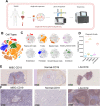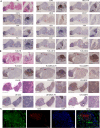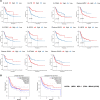Single-cell sequencing reveals the heterogeneity of B cells and tertiary lymphoid structures in muscle-invasive bladder cancer
- PMID: 38216927
- PMCID: PMC10787393
- DOI: 10.1186/s12967-024-04860-1
Single-cell sequencing reveals the heterogeneity of B cells and tertiary lymphoid structures in muscle-invasive bladder cancer
Abstract
Background: Muscle-invasive bladder cancer (MIBC) is a highly aggressive disease with a poor prognosis. B cells are crucial factors in tumor suppression, and tertiary lymphoid structures (TLSs) facilitate immune cell recruitment to the tumor microenvironment (TME). However, the function and mechanisms of tumor-infiltrating B cells and TLSs in MIBC need to be explored further.
Methods: We performed single-cell RNA sequencing analysis of 11,612 B cells and 55,392 T cells from 12 bladder cancer patients and found naïve B cells, proliferating B cells, plasma cells, interferon-stimulated B cells and germinal center-associated B cells, and described the phenotype, gene enrichment, cell-cell communication, biological processes. We utilized immunohistochemistry (IHC) and immunofluorescence (IF) to describe TLSs morphology in MIBC.
Results: The interferon-stimulated B-cell subtype (B-ISG15) and germinal center-associated B-cell subtypes (B-LMO2, B-STMN1) were significantly enriched in MIBC. TLSs in MIBC exhibited a distinct follicular structure characterized by a central region of B cells resembling a germinal center surrounded by T cells. CellChat analysis showed that CXCL13 + T cells play a pivotal role in recruiting CXCR5 + B cells. Cell migration experiments demonstrated the chemoattraction of CXCL13 toward CXCR5 + B cells. Importantly, the infiltration of the interferon-stimulated B-cell subtype and the presence of TLSs correlated with a more favorable prognosis in MIBC.
Conclusions: The study revealed the heterogeneity of B-cell subtypes in MIBC and suggests a pivotal role of TLSs in MIBC outcomes. Our study provides novel insights that contribute to the precision treatment of MIBC.
Keywords: B cells; CXCL13; Muscle-invasive bladder cancer; Single-cell sequencing; Tertiary lymphoid structures.
© 2024. The Author(s).
Conflict of interest statement
The authors declare no competing interests.
Figures







References
Publication types
MeSH terms
Substances
Grants and funding
LinkOut - more resources
Full Text Sources
Medical
Miscellaneous

